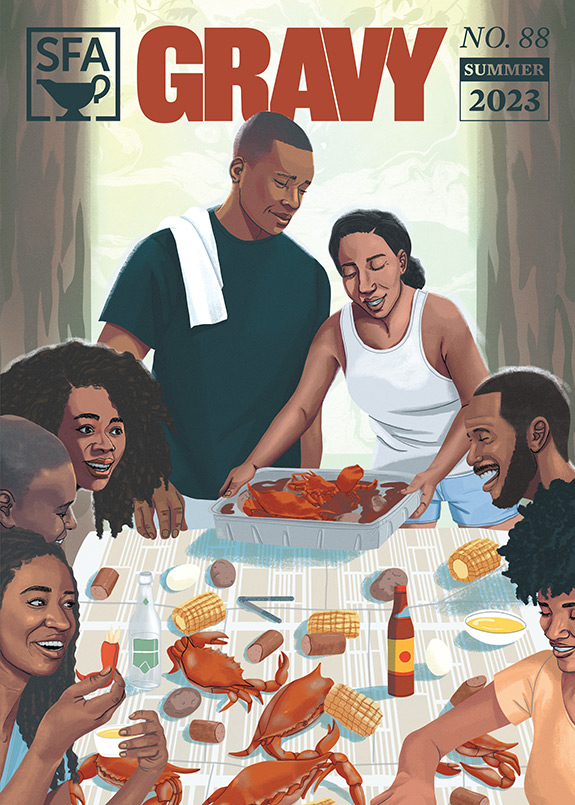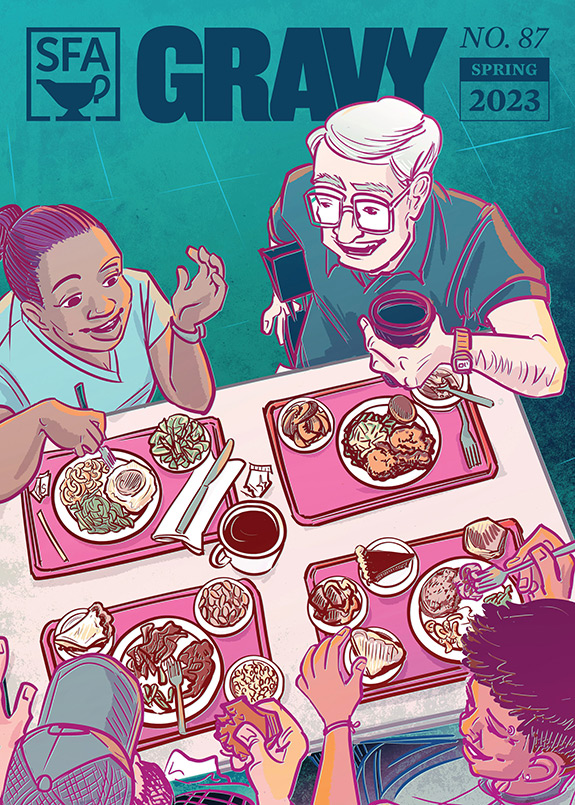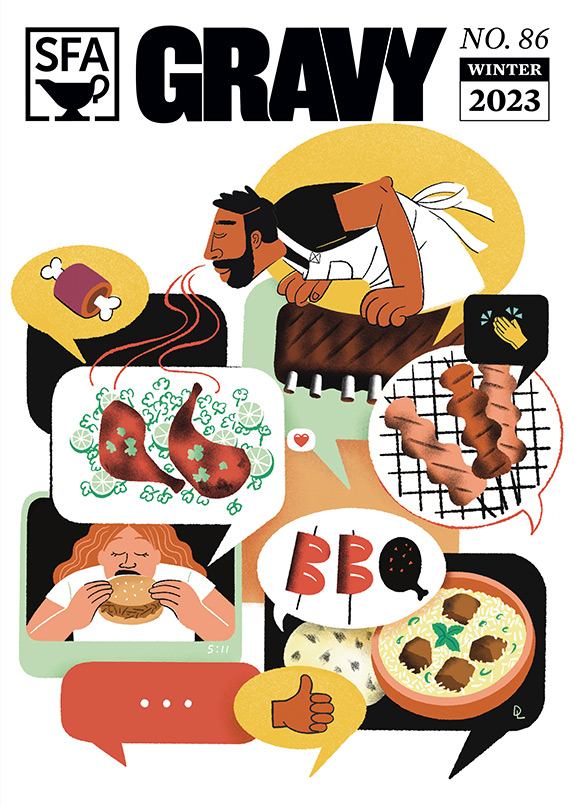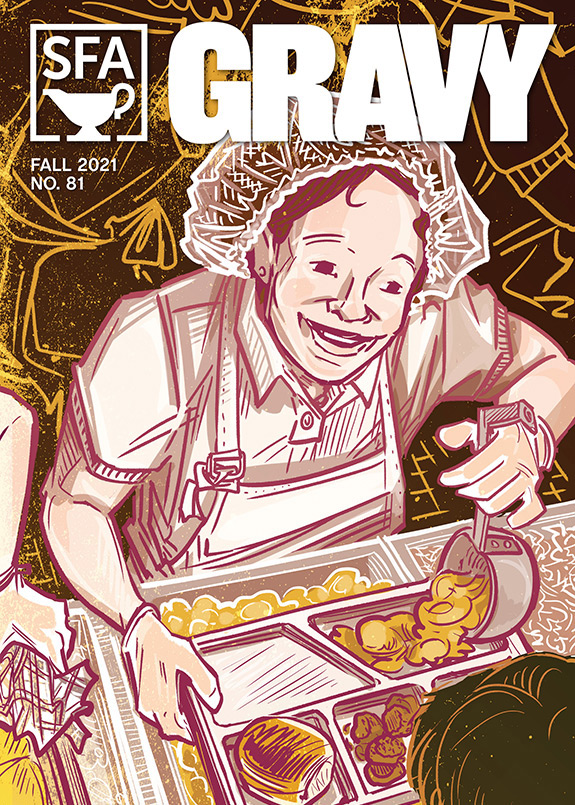
Silas House is the author of five novels, three plays, and one book of nonfiction. He is the NEH Chair of Appalachian Studies at Berea College. He wrote this essay for the Appalachian-themed issue #51 of our Gravy quarterly. We’re pleased to share it with you here.
The Indulgence of Pickled Baloney
In Appalachia, a simple snack equaled attainment.
Dot’s Grocery, owned by my aunt, was the community center of tiny Fariston, Kentucky: a therapist’s office, sometimes a church, and—always—a storytelling school. Everyone gathered there to gossip and to seek the sage kitchen wisdom of Dot. She kept a Virginia Slim permanently perched in her fuchsia-lipsticked mouth and latched her steely blue-eyed gaze on her customers while they spilled their guts and sought her advice. A few times I witnessed prayer services there. The epicenter of a largely Holiness community was hard-pressed to escape that, after all. There were always the big tales, swirling around like the twisting smoke of the regulars’ cigarettes (in my memory, all of them smoked, everyone).
Looking back, the stories are what matter the most. But when I was a child in the 1980s my favorite things were: the cakes-and-candy rack, the old-timey Coke cooler with the silver sliding doors on top, and the huge jar of pickled baloney that sat on the counter next to the cash register. Beside it were a loose roll of paper towels, a box of wax paper, a sleeve or two of Premium saltines, and a large Old Hickory–brand knife.
Cutting pickled baloney was a rite of passage, usually reserved for children who were past the age of ten. That may sound young to wield a butcher knife, but we were country children who had attended hog killings, watched the dressing of squirrels, cleaned our own fish, and stood in chairs by the stove so we could learn to cook.
The pickled baloney, submerged in vinegar, was one corkscrew of delicious processed meat. I did not know then, and wouldn’t have cared, that baloney is usually made up of the afterthoughts of pork or beef: organs, trimmings, and the like. All I knew was that it was scrumptious when paired with an ice-cold Dr Pepper and a handful of saltines. Dot indulged me with treats when I came to the store, and I usually asked if, instead of getting a free banana Moon Pie or Bit-O-Honey, I could opt for pickled baloney. “Why sure,” Dot always answered, expelling two wisps of blue smoke with her words.

Besides the taste, which my Uncle Dave said was “so good you had to pat your foot to eat it,” there was the added bonus of brandishing the knife and sawing off my own piece, proving I was not a little boy anymore. I was an eleven-year-old eater of pickled baloney.
Pickled baloney was a delicacy in the rural stores of Appalachia, showcased right on the counter, where no one could miss it. Most people headed straight for the pickled baloney jar when they were sitting for a spell at Dot’s. Others eyed the jar with desire, knowing they couldn’t afford to add it to their bill. Dot’s thrived in that last period of the jottemdown store, a small community grocery where local folks could buy on credit. The name referred to the fact that such stores kept a spiral-bound notebook on the counter to “jot down” purchases. Each customer had their own page and each month what they owed was totaled up. They came in on payday and paid off their debts to Dot. She seldom turned anyone down for more credit, even if they owed her for months on end. After all, she had opened the store as a single mother supporting two daughters.

Many people I know now scoff at the very idea of eating baloney, much less pickled baloney. They do not understand that the purchase of such a thing was an extravagance, an indulgence. This was a different time. A different world. I knew no one who went to the movies or shopped on a whim. These luxuries required a long period of saving. They had to be planned far in advance.
We were the progeny of people who had been very, very poor. And although I’ve painted the hamlet of Fariston as a romantic, bucolic place where people had the live-long day to gather around a woodstove in a little store to tell stories, the truth is much more complex than all that. This was a place where poverty existed alongside great wealth.
A few yards from Dot’s Grocery was a sprawling trailer park occupied by people who worked minimum-wage jobs in fast-food restaurants or at the Dollar General. Dogs meandered about the dirt yards, and children played on the porches while their fathers slept after working third shift or their mothers hung out lines of clothes that flapped in the wind.
Just past the trailer park loomed the huge mansion owned by a coal baron and built to resemble South Fork from TV’s Dallas. Its opulence proclaimed, “We made it. You did not.” The house was a few miles from the massive strip mine that destroyed that part of the county. The riches from that mine built the manor, but no matter: The family had a three-car garage. And twelve-foot pillars flanked the front porch.
I am sure that the people in the South Fork mansion didn’t serve pickled baloney hors d’oeuvres at their parties. But for people raised like my parents, pickled baloney was a symbol of attainment.
When she bought one of the gallon jars, my mother would return from the grocery with a giddy excitement. As children, she and my father had never been allowed such indulgences. Both grew up in the sort of poverty people always associate with Appalachia. Still, they were quick to tell you they had never been hungry. Country people were good at providing food for themselves, whether by growing it, bartering for it, or making it stretch. Snacks were rare and sniffed of affluence.
By the time I was a child my parents had worked so long and so hard they had firmly rooted us in the middle class. We did not have a house that looked like J.R.’s and Sue Ellen’s, but we had recently left the trailer park and moved into a small five-room house with a grassy yard dotted by pink dogwood trees. The buying of pickled baloney, which might be considered the lowest of foods, meant something to my family and our community.
Every once in a while I get a terrific craving for pickled baloney. I eat it with a strange mixture of guilt, because I know what’s in it, and delicious nostalgia for a place and time that is gone forever. Food is more than merely taste or nourishment. In Appalachia, food is memory and heritage.
Today, when I cut a hunk of meat off that corkscrew, when I draw in the sharp fragrance of vinegar as I peel off the baloney casing and take a bite, I remember the customers in Dot’s Grocery. Their joys and sorrows, always on full display. I recall afternoons spent with my father after he woke up, before he left to work the third shift. I remember my Aunt Dot, gone now, and the way she cared for the whole community, provided a place for them, jotted down their purchases, and sometimes wadded up a whole sheet of debt when she realized that family was doing all they could to support themselves. That way of life is gone now, and I miss it so badly, in all of its awfulness and beauty.








